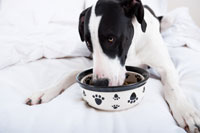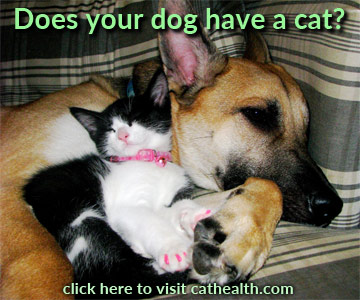Bloat in Dogs: Gastric Dilatation and Volvulus (GDV)

Gastric dilatation and volvulus (GDV), also commonly called bloat in dogs, is one of the most serious and life-threatening canine emergency situations that can occur. Understanding the signs and seeking veterinary care without delay can make all the difference for your pet. If left untreated, this condition can become rapidly fatal.
What Is Gastric Dilatation and Volvulus?
Gastric dilatation is a condition in which a dog's stomach expands with air or "dilates" but remains in the same position. This may be uncomfortable for your dog and he may display signs such as panting, restlessness, and abdominal distention. This condition is often seen in adult dogs or puppies that eat a meal rapidly. With time, this condition may resolve on its own and only requires medical treatment if the above signs persist or worsen.
Gastric dilatation can become life-threatening when it also includes volvulus, meaning the dilated stomach twists on itself. This leads to further stomach dilation, lack of good blood flow or perfusion to the rest of the body, and eventual circulatory shock. Often the spleen also twists with the stomach and can lead to blood loss and further complications.
The term "bloat," while technically referring to only the dilatation portion of the condition, is often used interchangeably with a full GDV situation.
What Causes GDV in Dogs?
There are several known predisposing causes of this condition:
-
Age
Large breed dogs (less than 99 lbs) over the age of 5 years and giant breed dogs (greater than 99 lbs) over the age of 3 years are at the highest risk of developing GDV.
-
Breed
The following dog breeds are most frequently affected by GDV:
- German shepherd
- Great Dane
- Doberman pinscher
- Saint bernard
- Standard poodle
- Irish setter
- Bouvier
- Wolfhound
- Old English sheepdog
- Akita
- Mastiff
-
Eating Habits
GDV is seen more often in dogs that are fed one large meal a day. Feeding from elevated food bowls, previously thought to decrease risk, increases risk. Dogs that eat rapidly may also be at increased risk of developing the condition, possibly due to swallowing air while eating. A deep-chested dog that exercised heavily after eating a large meal is a classic presentation of bloat in dogs. Restricting water before and after meals is also associated with higher rates of GDV.
-
Physical Traits
Deep and narrow chest conformation is a high risk factor.
-
Stressful Situations
Dogs that experience a stressful situation such as boarding are at a greater risk of developing GDV. Also dogs that have an anxious or fearful temperament are more likely to get the condition.
-
Hereditary Factors
Dogs that have a first degree relative (parents, siblings, or puppies) that has experienced GDV have a greater chance of being affected. Also, dogs with an inherited condition called exocrine pancreatic insufficiency (EPI) are more likely to develop GDV.
What Are the Signs of GDV in Dogs?
The signs of GDV depend on the stage of the condition. Early on, dogs may show discomfort, restlessness, panting, drooling, and unproductive vomiting (retching). As the stomach continues to expand and other internal organs are affected, signs often include abdominal distention, pain, pale gums, weakness, and collapse.
Is GDV in Dogs Serious?
GDV is one of the most serious and life-threatening emergencies your dog can experience, and you should seek veterinary care immediately if you suspect it. You should expect your veterinarian to take a right-sided abdominal x-ray initially to determine if your dog's stomach is just distended (gastric dilatation) or is also twisted (gastric dilatation and volvulus). Other necessary tests include blood tests, ECG (to evaluate the heart rhythm), blood pressure, and blood clotting evaluation.
What Is the Treatment for GDV in Dogs?
Once your dog is diagnosed with GDV, your veterinarian will prescribe a variety of treatments in preparation for surgery. A large volume of intravenous fluids will be administered to improve blood pressure. If your dog's blood pressure does not respond to the fluids or if your dog is diagnosed with a clotting problem, additional fluids (starch- containing fluids or plasma) will be used. Pain medications and antibiotics are also indicated. Ultimately, abdominal surgery will be necessary to reposition the stomach, suture the stomach in a fixed position (called a gastropexy), and possibly remove the spleen if it shows signs of damage.
What Is the Prognosis for GDV in Dogs?
There are several studies looking at the survival in dogs after experiencing GDV. In general, dogs that do not receive surgery, that is if the stomach deflates or untwists, either on its own or with medical management, will have a 70% chance of the condition recurring. In cases where the condition cannot be corrected medically, the prognosis is grave with a death rate of 100% without surgery. In cases where surgery is performed early in the course of GDV, survival rates are reported between 80-90%. There are several factors that can influence the success rate of GDV treatment in your dog. Conditions that are reported to be associated with poor outcomes include:
- Necrotic (dead) areas of the stomach found at surgery
- Development of abnormal heart rhythm
- Blood-clotting disorders
Can I Prevent GDV from Occurring in My Dog?
There are several preventive measures you can take to decrease your dog's chance of developing GDV. For breeds at high risk, your veterinarian can perform a gastropexy, a surgical repositioning and stabilization of the stomach, at a young age. Often this can be done at the time of spaying or neutering. Avoiding the risk factors listed above is another way to decrease the chances of your dog developing the condition. Recommendations include:
- Avoid stressful situations such as boarding
- Do not use elevated food bowls
- Do not exercise one hour prior to and after eating
- Feed a high quality diet
- Do not feed a single large meal daily
- Include some canned food in your dog's diet (with your veterinarian's input)
- Consider using an anti-bloat bowl that forces your dog to eat more slowly.
You May Also Like These Articles:
Wet Food Vs. Dry Food For Dogs
Foods Toxic to Dogs - Slideshow
Dog Weight Loss: Tips For Helping Your Dog Lose Weight
Walking Your Dog to Help with Weight Loss
Dog Adoption: What You Need to Know
How to Be Prepared for Your Dog's Veterinary Bills
Disclaimer: This website is not intended to replace professional consultation, diagnosis, or treatment by a licensed veterinarian. If you require any veterinary related advice, contact your veterinarian promptly. Information at DogHealth.com is exclusively of a general reference nature. Do not disregard veterinary advice or delay treatment as a result of accessing information at this site. Just Answer is an external service not affiliated with DogHealth.com.
Notice: Ask-a-Vet is an affiliated service for those who wish to speak with a veterinary professional about their pet's specific condition. Initially, a bot will ask questions to determine the general nature of your concern. Then, you will be transferred to a human. There is a charge for the service if you choose to connect to a veterinarian. Ask-a-Vet is not manned by the staff or owners of DogHealth.com, and the advice given should not delay or replace a visit to your veterinarian.



